- Expert advice/
- Wedding planning 101/
- Wedding day/
- 8 Wedding Ceremony Scripts to Borrow & Printables
- Wedding day
8 Wedding Ceremony Scripts to Borrow & Printables
Find beautiful wedding ceremony scripts ranging from unique to traditional. Print and borrow them, or get inspiration to write your own!
Last updated June 10, 2024
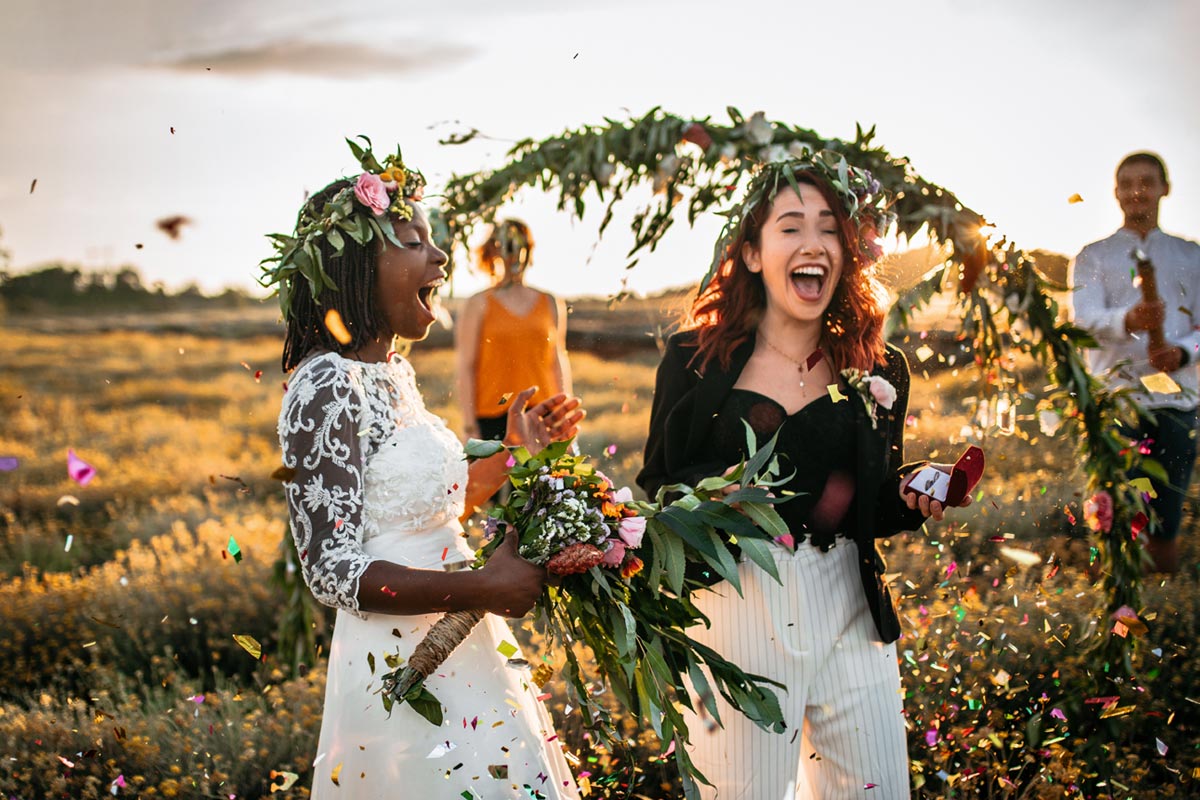
Inside this article:
- Simple wedding ceremony script
- Modern wedding ceremony script
- Humorous wedding ceremony script
- Inclusive wedding ceremony script
- Christian wedding ceremony script
- Catholic wedding ceremony script
- Jewish wedding ceremony script
- Protestant wedding ceremony script
- 4 Tips for writing your own ceremony script
- Simple wedding ceremony script starter outline
- FAQs about wedding ceremony scripts
- Summarizing ceremony and officiant wedding scripts
In the midst of the organized chaos of wedding planning, the wedding ceremony is often left until the last minute. But the ceremony is quite significant—after all, it’s the part where you and your future spouse actually become joined in marriage.
We all know about the “I do’s” of a wedding ceremony, but the rest of your ceremony is just as important. While you want to create a wedding ceremony script that’s meaningful and personal to you and your future spouse, figuring out how to do this can leave some couples scratching their heads. If you’re wondering where to begin writing your wedding ceremony script, our tips and examples below are here to help.

Simple wedding ceremony script
This script has been reviewed by Rev. Lisann G. Valentin, an ordained minister at Universal Life Church.
For a nonreligious wedding ceremony, there’s no standard script you need to adhere to. The script below can be a helpful starting point for a simple wedding ceremony you can build upon and personalize however you like.
Opening words/welcome
The ceremony will begin with the officiant addressing the reception.
Officiant: “Welcome friends, family, and loved ones. We’re gathered here today to celebrate [PARTNER A] and [PARTNER B] in their lifelong commitment of love to each other. Finding your life partner is a true joy, and the commitment to share in life’s ups and downs as one is no small feat. While marriage will bring its own challenges and triumphs, let this day be a reminder of what your love has already accomplished, as well as the possibilities for your partnership as you grow together for years to come.”
Reading
While a simple wedding ceremony might omit this part altogether, some couples like to personalize their ceremony wedding scripts with a chosen reading or song to celebrate their union. A close friend or family member, the officiant, or the couple themselves might perform readings. For example, the officiant might call upon a chosen friend or family member to perform an original poem or share a story about the couple’s relationship.
Officiant: “As our reading today, [PARTNER A/B] has asked [his, her] [friend/cousin/other family member] to recite an original poem in honor of their union.”
[Reading proceeds.]
Vows and ring exchange
Couples may choose to write their own vows or omit reciting vows altogether.
Officiant to reception: “[PARTNER A] and [PARTNER B] will now exchange rings as a symbol of their love and lifelong commitment.”
At this point, couples may exchange their vows (if desired) before placing their rings on each other's fingers. Below is an example of vows that might be exchanged:
Partner A to Partner B: “With this ring, I promise to support you, care for you, laugh with you, share in your burdens, be honest with you, and be faithful to you in all that we may face in the years ahead. I promise to love you with everything I have, from this day forward and beyond.”
Partner B to Partner A: “With this ring, I promise to love you and commit myself to you for the rest of my life. I promise to stand by your side, be there for you always, and to find laughter and joy even in tough times. I promise to love and accept you just as you are, and grow with you for every year to come.”
Declaration of intent
Officiant to Partner A: “Do you, [PARTNER A], take [PARTNER B] to be your lawfully wedded [husband, wife, partner]? Will you honor and cherish them, continue to deepen your understanding of them, and treat them with love and compassion in joy and pain, sickness and health, and whatever life might throw your way?”
Partner A: “I will” or “I do.”
Officiant to Partner B: “Do you, [PARTNER B], take [PARTNER A] to be your lawfully wedded [wife, husband, partner]? Will you honor and cherish them, continue to deepen your understanding of them, and treat them with love and compassion in joy and pain, sickness and health, and whatever life might throw your way?”
Partner B: “I will” or “I do.”
Pronouncement
Finally, the officiant will pronounce the couple as married. To capture the perfect moment, couples might also request that the officiant steps to the side for the kiss during the wedding nuptials.
Officiant to all: “By the authority vested in me, and with the trust of you all here today, I now declare you joined in love. You may now kiss!"
Closing
Officiant to all: “Thank you all for joining in this momentous occasion for [PARTNER A] and [PARTNER B]! They now invite you to join them for a reception at [LOCATION]. Thank you all!”
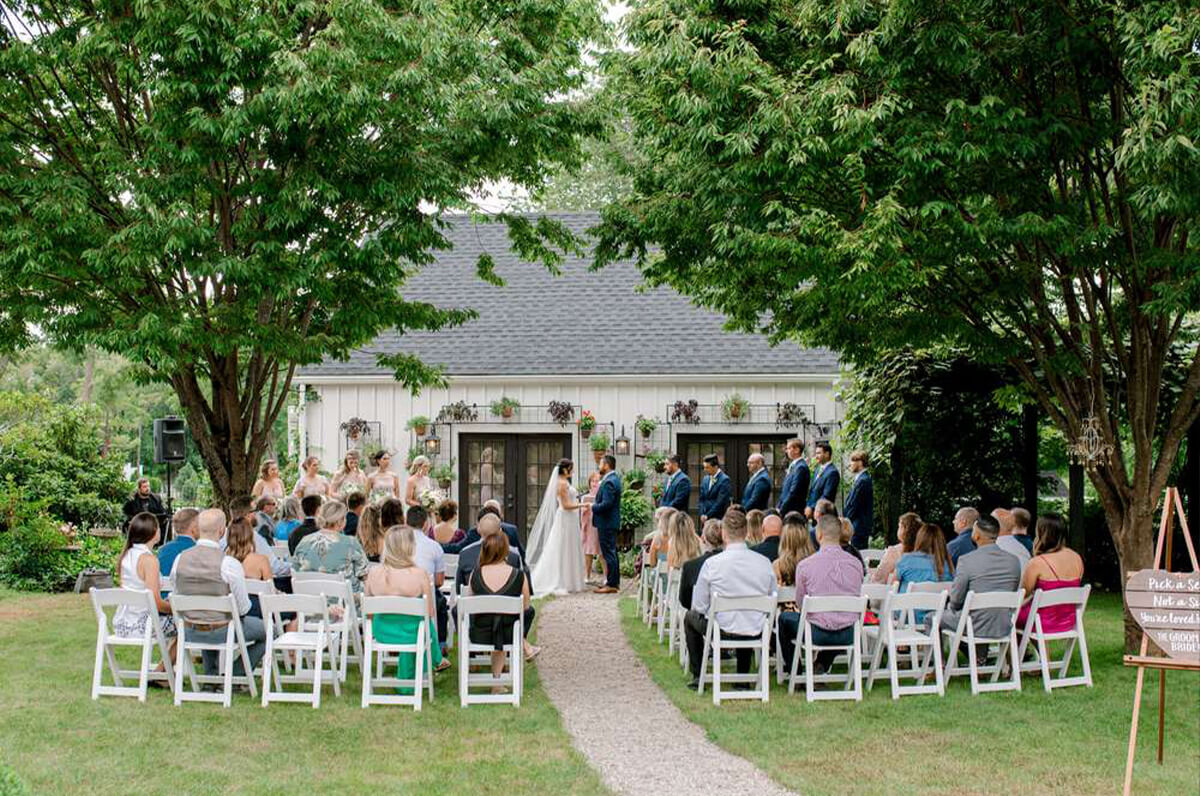
Modern wedding ceremony script
This script has been reviewed by Sheena Wheadon, licensed wedding officiant at Why Knot Weddings.
Any wedding ceremony can take a modern spin. Any number of personal touches can be added to your ceremony to make it more modern—whether you want to include your pets, switch up how your wedding party is presented, or simply add some modern flair to your wedding vows and readings. Personalizing your wedding ceremony script is a great way to infuse who you really are into your big day.
Opening words/welcome
The officiant script will begin by welcoming the reception.
Officiant: “Good afternoon and welcome! We’d like to thank everyone on this beautiful day for coming to support [PARTNER A] and [PARTNER B] in this exciting endeavor and union. Your friendship and support has helped to strengthen them as they’ve made their way to this moment, and they thank you for being here.”
Reading
Couples may choose to include a reading in their marriage ceremony script. This reading can be anything you wish, whether it’s a special poem, a reading from a book, a quote from a movie, or a story about the couple’s relationship shared by a close friend or family member.
[Reading proceeds.]
Vows Exchange
Many modern couples opt to write their own wedding vows or omit them altogether. It’s up to you! Below is an example of modern wedding vows:
Officiant to couple: “[PARTNER A] and [PARTNER B], please exchange your vows.”
Partner A to Partner B: “[NAME], you’re my best friend. I’m in awe of your lightness, your kindness, and the purity of what it looks like to be loved by someone like you. It’s a love with no expectations, no strings attached, only a desire to support me and see me fulfilled. To know and be known by you is a gift and a privilege. I know we were made for each other. So here’s what I promise:
I vow always to strive to be the best version of myself so that I can show up for you every single day. I vow to seek joy and hope even in dark times and be there for you when you need me. I vow to trust you and love you unconditionally. I vow to continue to learn from the examples of patience and selflessness that you have always embodied.”
Partner B to Partner A: “[NAME], I love you with my whole heart. You’ve loved me with a loyalty that I’d never experienced before, and didn’t even know existed. You have seen every part of me, and even at my lowest you have stood by my side. You’ve never given up on me, and I have no doubt that you are the person I’m meant to spend my life with. I vow to keep a soft heart when challenges come, and to be aware of my words and actions and how they affect you. I vow to support you in all things, to love you well, and to create a life we’re proud of. Life is fleeting, and I want to cherish every minute of it with you.”
Declaration of intent
Officiant to couple: “[PARTNER A] and [PARTNER B], do you take one another as partners from this day forward?”
Couple in unison: “We do.”
Officiant: “Will you love, honor, and cherish one another as partners for the rest of your lives?”
Couple responds: “We will.”
Ring exchange
Officiant to reception: “[PARTNER A] and [PARTNER B] have chosen these rings as a symbol of their unbreakable love. Please place these rings on each other’s fingers and repeat after me:
‘I give you this ring as a reminder of our love that unites, inspires, and celebrates what we have.’”
[Couple repeats to each other.]
Pronouncement
Finally, the officiant will pronounce the couple as legally wed:
Officiant to all: “By the authority vested in me, it is with joy that I pronounce you married. Now kiss and go celebrate!”
Closing
Officiant to all: “Thank you all for joining in this beautiful occasion for [PARTNER A] and [PARTNER B]! They now invite you to join them for a reception at [LOCATION]. Thank you all!”
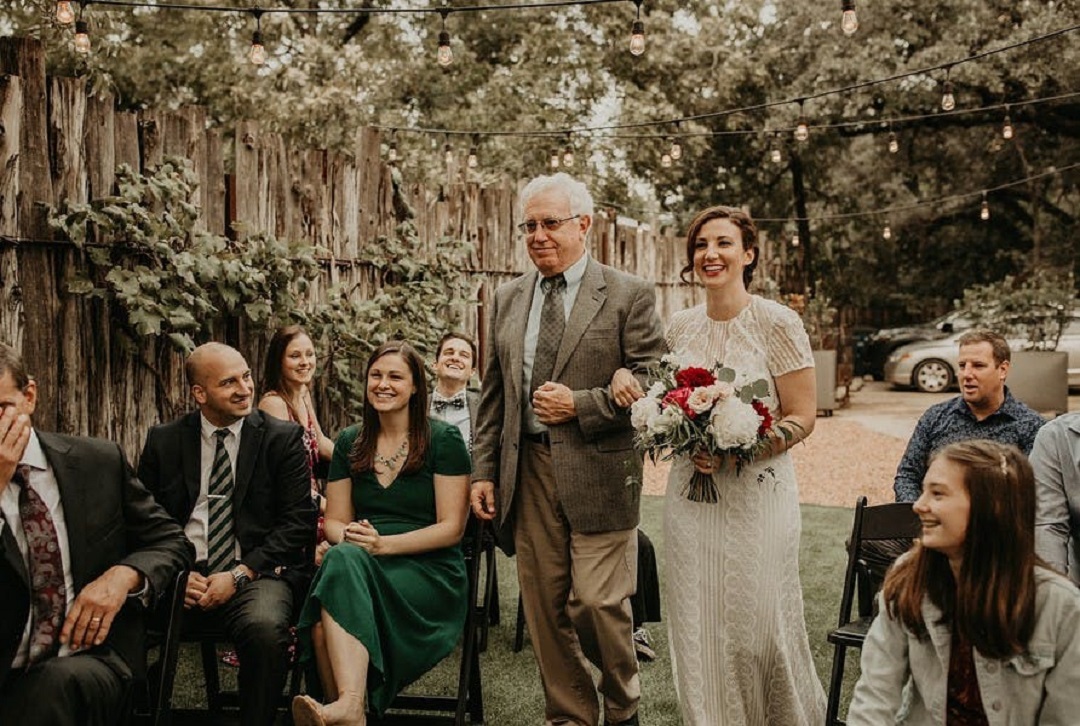
Humorous wedding ceremony script
This script has been reviewed by Rev. Lisann G. Valentin, an ordained minister at Universal Life Church.
There’s no rule that says your wedding ceremony has to be serious from start to finish. Some couples prefer to add a bit of humor to their ceremony for a more lighthearted affair. The following funny wedding ceremony script has all the required legal elements of becoming legally married, with a humorous touch to keep your guests on their toes.
Opening words/welcome
The officiant will begin by welcoming the crowd and introducing the ceremony.
Officiant to all: “Hello and welcome! We’re here today because [PARTNER A] and [PARTNER B] have decided they love each other so much that they want to get the government involved! But in all seriousness, a huge thanks to all who have joined us. We promise we’ll get these two hitched quickly so you can make a beeline to the open bar!
I’d like to take this opportunity to ponder the meaning of marriage. Now I know I made a joke about these two loving each other so much they’ve decided to get the government involved, but we know that’s not all marriage is. It’s a tradition, yes, but it’s so much more. It might take a lot of work and compromise, but at the end of the day, this is about choosing your person until the end of this thing we call life. So no matter how many dishes they leave in the sink, no matter how horrible their cooking is, no matter how bad their mood might be on occasion—you’ve got someone who chooses to stick with you through it all. And that’s what marriage is about!”
Reading
Including readings in your ceremony is optional, but some couples opt to personalize their ceremony with a particular reading, quote, or story. Some humorous wedding ceremonies might involve a close friend or family member sharing a lighthearted account of the couple’s relationship, with some light humor to get a laugh out of the crowd. The wedding ceremony officiant script can even include fun elements,
Officiant: “As our reading today, [PARTNER A/B} has asked [his, her] [friend/cousin/other family member] to share a personal story of their relationship in honor of their marriage today.”
[Reading proceeds.]
Vows and ring exchange
At this point, couples may exchange vows if they’ve chosen to write them. Here’s an example of wedding vows with a little humor:
Officiant to Partner A: “Now, it’s time to put a ring on it! [PARTNER A], repeat after me: ‘I give you this ring as a symbol that I will love and cherish you, and that I’ll try to keep my mouth shut when it’s your turn to choose the movie we watch.’”
[Partner A repeats.]
Officiant to Partner B: “[PARTNER B], repeat after me: ‘I give you this ring as a symbol that I will love and cherish you, and that I’ll consider making you dinner every once in a while.’”
[Partner B repeats.]
Declaration of intent
Officiant to Partner A: “Do you, [PARTNER A], take [PARTNER B] to be your lawfully wedded [husband, wife, partner], to love and cherish them for better or for worse, in sickness and in health, and reap as many tax benefits as you can for as long as you both shall live?”
Partner A: “I do.”
Officiant to Partner B: “Do you, [PARTNER B], take [PARTNER A] to be your lawfully wedded [wife, husband, partner], to love and cherish them for better or for worse, in sickness and in health, and reap as many tax benefits as you can for as long as you both shall live?”
Partner B: “I do.”
Pronouncement
Now, the officiant will pronounce the couple as legally wed:
Officiant: “What a romantic exchange. Now, I guess there’s only one thing left to do: By the power vested in me, I now pronounce you [husband and wife, husband and husband, wife and wife]! Now kiss!”
Closing
Officiant to all: “That’s a wrap on the formal proceedings of today. [PARTNER A] and [PARTNER B] will greet you in [LOCATION] at [TIME]. We thank you for coming—now get out of here and go celebrate!”
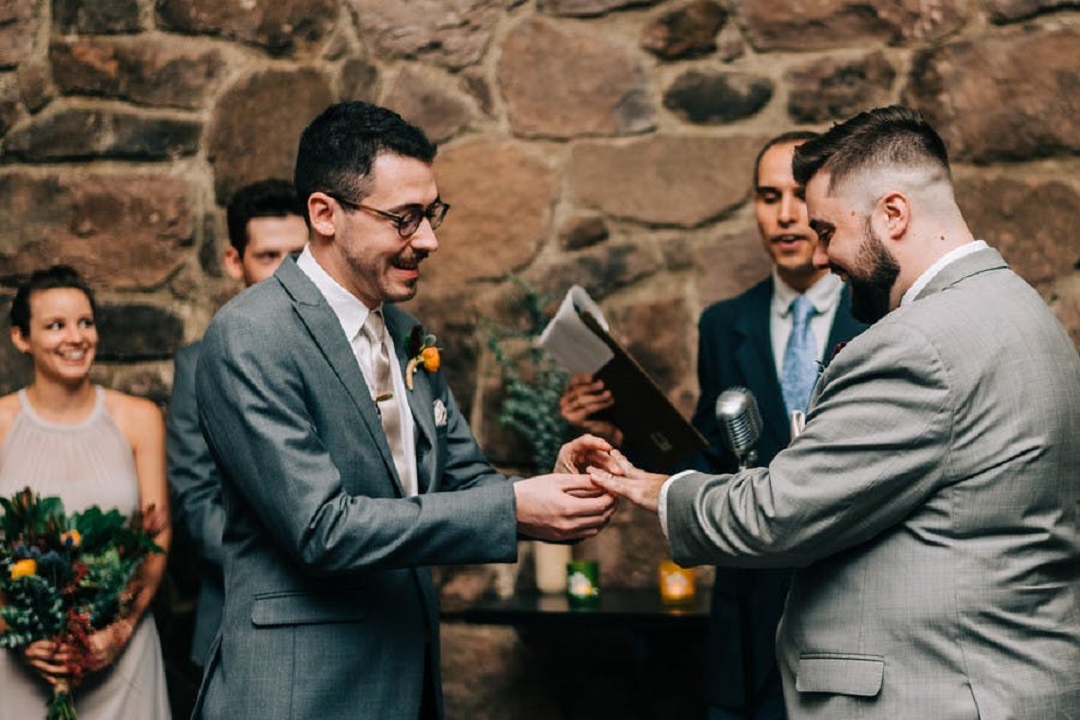
Inclusive wedding ceremony script
This script has been reviewed by Sheena Wheadon, licensed wedding officiant at Why Knot Weddings.
While traditional gender roles often make up the bulk of how many sample wedding ceremony scripts are written, this doesn’t have to be the case for a more inclusive ceremony. The following example script does away with gendered language and puts the focus on the love shared between the couple and what that means for them.
Opening words/welcome
The officiant will begin by welcoming the reception. This is also when the wedding officiant script can include any specific announcements, like requesting guests to silence their phones.
Officiant: “Welcome friends, family, and loved ones! We’re gathered here today in celebration of (Partner A) and (Partner B) and to bear witness as they join their lives in marriage. On behalf of (Partner A) and (Partner B), it’s a true pleasure to have you here to celebrate this incredible moment.
Love is one of the greatest gifts life has to offer. Love offers hope, joy, comfort, and security, in good times and bad. Love is what spurs our personal growth and allows us to face life and all its challenges, with the unending support of the person we’ve chosen to commit our lives to. (Partner A) and (Partner B) stand before you today to share the love and happiness in their hearts as they take their relationship to a deeper level of commitment by making a passage into marriage.”
Reading
While totally optional, couples can choose to include a reading of their choice in their ceremony. This can be anything from a particular poem or section from a book to a special movie quote or personal story about the couple’s relationship. Couples might have the officiant perform the reading or have a loved one come up to share instead.
Officiant: “(Partner A) and (Partner B) have selected a reading from [SOURCE] that represents their unique journey and the commitment they’re making today.”
[Reading proceeds.]
Vows exchange
Couples who have chosen to write their own wedding vows will recite them here. These could be in a question-and-answer format or long-form vows written beforehand (or a combination of both). Couples can also ask their officiant to step to the side during the vow readings—it helps make the moment more intimate!
Here’s an example of wedding vows for you to work from:
Officiant to couple: “Marriage is a lifelong commitment to love and care for each other to the best of your ability. Are you both ready to take this step together?”
Couple responds: “Yes!”
Officiant to couple: “Do you promise to care for each other, treat each other with respect and compassion, and to always move toward love in your efforts to support one another?”
Couple responds: “We do.”
Officiant to couple: “Do you promise to meet each challenge and triumph with integrity, gratitude, and patience, and to strive to learn and grow together for all of your days?”
Couple responds: “We do.”
Affirmation of family and friends
Officiant to reception: “Do you, the family and friends of (Partner A) and (Partner B), give your full support today and wish them a lifetime of happiness together?”
Reception responds: “We do.”
Expression of intent
Officiant: “In the presence and witness of the loved ones you have gathered here today, I now ask you to state your intentions.
(Partner A) and (Partner B), have you come here freely and without reservation to give yourselves to each other in the commitment of marriage?”
Couple responds: “Yes.”
Officiant: “Once more, will you love, honor, and cherish one another as partners for the rest of your lives?”
Couple responds: “We will.”
Ring exchange
Officiant to reception: “(Partner A) and (Partner B), please repeat after me:
‘I give you this ring as a symbol of the vows we’ve made today. I pledge to you my love, respect, and commitment. With everything that I am, I honor you.’”
[Couple repeats to each other.]
Pronouncement
Finally, the officiant will pronounce the couple as legally wed:
Officiant: “Now that you, (Partner A) and (Partner B), have promised to give yourselves fully to each other, to love each other through the vows you have made, and through the giving and receiving of these rings, it is my great pleasure by the power vested in me to now pronounce you married! You may now kiss!”
Closing/invitation to reception
Officiant to all: “Thank you all for joining in this joyous occasion for (Partner A) and (Partner B)! They now invite you to join them for a reception at [LOCATION]. Thank you all!”

Christian wedding ceremony script
This script has been reviewed by the ordained ministers at Universal Life Church Monastery.
As the name indicates, this script for weddings includes religious aspects, such as Bible readings and prayers. Feel free to personalize this idea to your liking and include more or fewer scriptural elements.
Processional
The processional is simply the beginning of the wedding ceremony, when guests are seated, followed by the entrance of the bridal party.
Invocation
Officiant to reception: "Welcome, loved ones. We are gathered here today in the sight of God and these witnesses to join together [PARTNER A] and [PARTNER B] in holy matrimony.”
Declaration of intent
The declaration of intent is a crucial element of any wedding ceremony, and is legally required to show consent among both parties to be married.
Officiant to the couple: "[PARTNER A] and [PARTNER B], you have come together this day so that the Lord may seal and strengthen your love in the presence of this minister of his word and this community of family and friends and so, in the presence of this gathering, I ask you to state your intentions:
Have you both come here freely and without reservation to give yourselves to each other in marriage? If so, answer by saying 'I have.'"
[Couple responds in unison with ‘I have.’]
Reading
A reading from the Bible is a common component in many Christian wedding ceremonies. While choosing a passage from Corinthians isn’t required, it’s a popular choice for many.
Officiant to reception: “A reading from the Apostle Paul, 1 Corinthians 13:4-7: ‘Love is patient, love is kind. It does not envy, it does not boast, it is not proud. It is not rude, it is not self-seeking, it is not easily angered, it keeps no record of wrongs. Love does not delight in evil but rejoices with the truth. It always protects, always trusts, always hopes, always perseveres.’
Let us pray for this couple as they make their marriage vows.
Father, as [PARTNER A] and [PARTNER B] pledge themselves to each other, help them and bless them that their love may be pure, and their vows may be true. Through Jesus Christ our Lord, amen."
Vows exchange
Today’s wedding vows are often personalized according to whatever feels right to the couple. However, a traditional statement of vows is also common in Christian wedding ceremonies.
Couple to each other: “I, [NAME], take thee, [NAME], to be my wedded (husband, wife), to have and to hold from this day forward, for better, for worse, for richer, for poorer, in sickness and in health, to love and to cherish, till death do us part. This is my solemn vow.”
Ring exchange
Officiant to Partner A: "[PARTNER A], please take the ring you have selected for [PARTNER B]. As you place it on his/her finger, repeat after me:
‘With this ring, I thee wed.’"
[Partner A repeats the phrase as they place the ring on Partner B’s finger]
Officiant to Partner B: "[PARTNER B], please take the ring you have selected for [PARTNER A]. As you place it on his/her finger, repeat after me:
‘With this ring, I thee wed.’"
[Partner B repeats the phrase as they place the ring on Partner A’s finger]
Prayer
One distinction of a Christian wedding ceremony script is including a prayer of blessing over the union.
Officiant to the couple: "May Jesus Christ, our Lord and Savior, always be at the center of the new lives you are now starting to build together, that you may know the ways of true love and kindness. May the Lord bless you both all the days of your lives and fill you with His joy. Amen."
Pronouncement
Officiant to reception: “By the power vested in me by the state of [STATE], I now pronounce you [husband and wife, husband and husband, wife and wife]! You may kiss the bride!”
Closing/invitation to reception
Officiant to all: “Thank you all for joining in this joyous occasion for [PARTNER A] and [PARTNER B]! They now invite you to join them for a reception at [LOCATION]. Thank you all!”
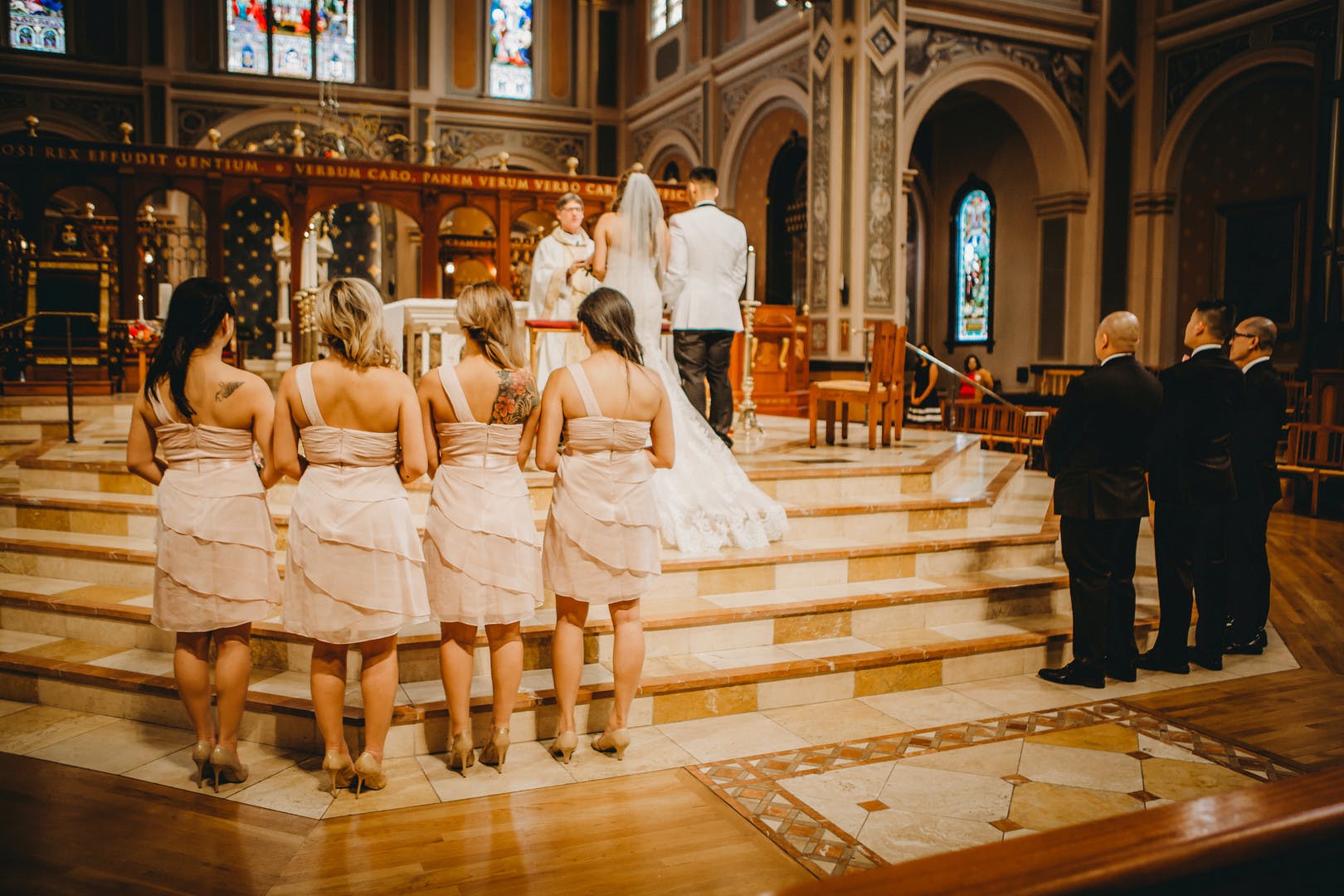
Catholic wedding ceremony script
This script has been reviewed by the ordained ministers at Universal Life Church Monastery.
As with the Christian script, this version includes religious elements. However, Catholic ceremonies are greatly rooted in tradition and include formal aspects at their core. The officiant is typically a priest, and these services traditionally take place in the church.
Entrance rite
As the entrance song is played, the assembly stands while the priest, ministers, and servers take their places, followed by the wedding party. The rest of this part of the processional can take two forms.
In the first form, the vested priests and servers greet the bridal party at the church door, and then all enter as is customary for Mass. In the second form, the priest and servers wait in the sanctuary area prepared for the couple to greet them when they arrive. In both forms, the priest always leads the procession.
Greeting
Once everyone is in place and the music has ended, the priest leads the sign of the cross, or the traditional beginning of Christian prayer, before greeting the assembly.
Priest: “In the name of the Father, and of the Son, and of the holy spirit.”
All respond: “Amen.”
Priest: “Grace to you and peace from God our Father and the Lord Jesus Christ.”
Collect (opening prayer)
The priest invites the assembly to pray. After he prays over the couple, the assembly is seated for the Liturgy of the Word.
Priest: “Be attentive to our prayers, O Lord, and in your kindness uphold what you have established for the increase of the human race, so that the union you have created may be kept safe by your assistance. Through our Lord Jesus Christ, your Son, who lives and reigns with you in the unity of the Holy Spirit, one God, forever and ever.”
Liturgy of the word
The liturgy of the word outside of mass usually includes three readings proclaimed by the priest, one from the Old Testament, one from the New Testament aside from the Gospel, and one from the Gospel. At the conclusion of each reading, the lector will say, "The Word of the Lord," and the assembly will respond, "Thanks be to God."
Priest: “A reading from the book of Genesis 1:26-28:
Then God said: ‘Let us make man in our image, after our likeness. Let them have dominion over the fish of the sea, the birds of the air, and the cattle, and over all the wild animals and all the creatures that crawl on the ground.” God created man in his image; in the image of God he created him; male and female, he created them. God blessed them, saying: “Be fertile and multiply; fill the earth and subdue it. Have dominion over the fish of the sea, the birds of the air, and all the living things that move on the earth.” God looked at everything he had made, and he found it very good. The word of the Lord.’
Assembly responds: “Thanks be to God.”
Priest: “A reading from the New Testament, 1 John 4:7-12:
Dear friends, let us love one another, for love comes from God. Everyone who loves has been born of God and knows God. Whoever does not love does not know God, because God is love. This is how God showed his love among us: He sent his one and only Son into the world that we might live through him. This is love: not that we loved God, but that he loved us and sent his Son as an atoning sacrifice for our sins. Dear friends, since God so loved us, we also ought to love one another. No one has ever seen God; but if we love one another, God lives in us and his love is made complete in us.
The word of the Lord.”
All respond: “Thanks be to God.”
Priest: “A reading from the Gospel, Matthew 5:13-16:
You are the salt of the earth. But if the salt loses its saltiness, how can it be made salty again? It is no longer good for anything, except to be thrown out and trampled underfoot. You are the light of the world. A town built on a hill cannot be hidden. Neither do people light a lamp and put it under a bowl. Instead they put it on its stand, and it gives light to everyone in the house. In the same way, let your light shine before others, that they may see your good deeds and glorify your Father in heaven.”
All respond: “Praise to you, Lord Jesus Christ.”
Assembly is seated.
Homily
The assembly is seated while the priest (or deacon) offers a homily taken from the Scripture readings. The priest uses this text to discuss the sacredness of Christian marriage, the dignity of conjugal love, the grace of the sacrament, and the responsibilities of married people.
Priest: "John 3:30 says ‘He must increase, but I must decrease.’
Those simple, direct words of St. John the Baptist, whose feast we celebrate today, summarize the life of the Christian disciple. In all things, we want Jesus to increase and our own will, our own desires, our own attachments, to decrease. In my heart, in my prayer, in my family, in my parish, in my work, in my study, in my leisure, in my entertainment - may the Lord Jesus increase!"
Celebration of matrimony
All stand, and the couple comes to the altar, flanked by their witnesses. The priest will address the couple with a celebration of matrimony:
Priest: “Dearly beloved, you have come together into the house of the church so that in the presence of the church’s minister and the community, your intention to enter into marriage may be strengthened by the Lord with a sacred seal.”
If both parties are Christian: “Christ abundantly blesses the love that binds you. Through a special sacrament, he enriches and strengthens those he has already consecrated by holy baptism, that you may be enriched with his blessing, so that you may have the strength to be faithful to each other forever, and assume all the responsibilities of married life. And so, in the presence of the church, I ask you to state your intentions.”
Address and statement of intentions
All stand, including the couple and witnesses, while the priest asks the couple some questions to state their intentions about their freedom of choice, fidelity to each other, and the acceptance and upbringing of children (if necessary).
Priest to couple: “[PARTNER A] and [PARTNER B], have you come here to enter into marriage without coercion, freely and wholeheartedly?”
Couple in unison: “I have.”
Priest to couple: “Are you prepared, as you follow the path of marriage, to love and honor each other for as long as you both shall live?”
Couple in unison: “I am.”
Exchange of consent
The couple will declare their consent to be married by stating their vows. If you’re writing your own vows, they must be prepared with the wedding script beforehand.
Partner A: “I, [NAME], take you, [NAME], to be my [wife, husband]. I promise to be faithful to you, in good times and in bad, in sickness and in health, to love you and to honor you all the days of my life.”
Partner B: “I, [NAME], take you, [NAME], to be my [husband, wife]. I promise to be faithful to you, in good times and in bad, in sickness and in health, to love you and to honor you all the days of my life.”
Blessing and giving of rings
Priest: “Bless, O Lord, these rings which we bless in your name. so that those who wear them may remain entirely faithful to each other, abide in peace and in your will, and live always in mutual charity. Through Christ our Lord.”
Assembly responds: “Amen.”
The priest now sprinkles the wedding rings with holy water before handing them to each partner.
Partner A: “[NAME], receive this ring as a sign of my love and fidelity. In the name of the father, and the son, and the holy spirit.”
[Partner A places the ring on Partner B’s finger]
Partner B: “[NAME], receive this ring as a sign of my love and fidelity. In the name of the father, and the son, and the holy spirit.”
[Partner B places the ring on Partner A’s finger]
Prayer
The priest and the assembly sing or pray the Lord’s Prayer in unison.
Nuptial blessing
The couple kneels at the altar, where the priest faces them and prays over them.
Priest: “Now let us humbly invoke God’s blessing upon this bride and groom, that in his kindness he may favor with his help those on whom he has bestowed the Sacrament of Matrimony.”
Communion
The priest performs communion and distributes the body and blood of Christ to Catholics in the assembly, starting with the newly married couple. An appropriate song is usually sung as the assembly proceeds to the altar for communion.
Pronouncement
Priest to reception: “By the power vested in me by the state of [STATE], I now pronounce you [husband and wife, husband and husband, wife and wife]! You may now kiss!”
Dismissal
Priest to assembly: “Go in peace to glorify the Lord with your life.”
Assembly responds: “Thanks be to God.”
Recessional
At the closing of the ceremony, the couple, bridal party, ministers, and the priest will proceed out of the church, often accompanied by music.
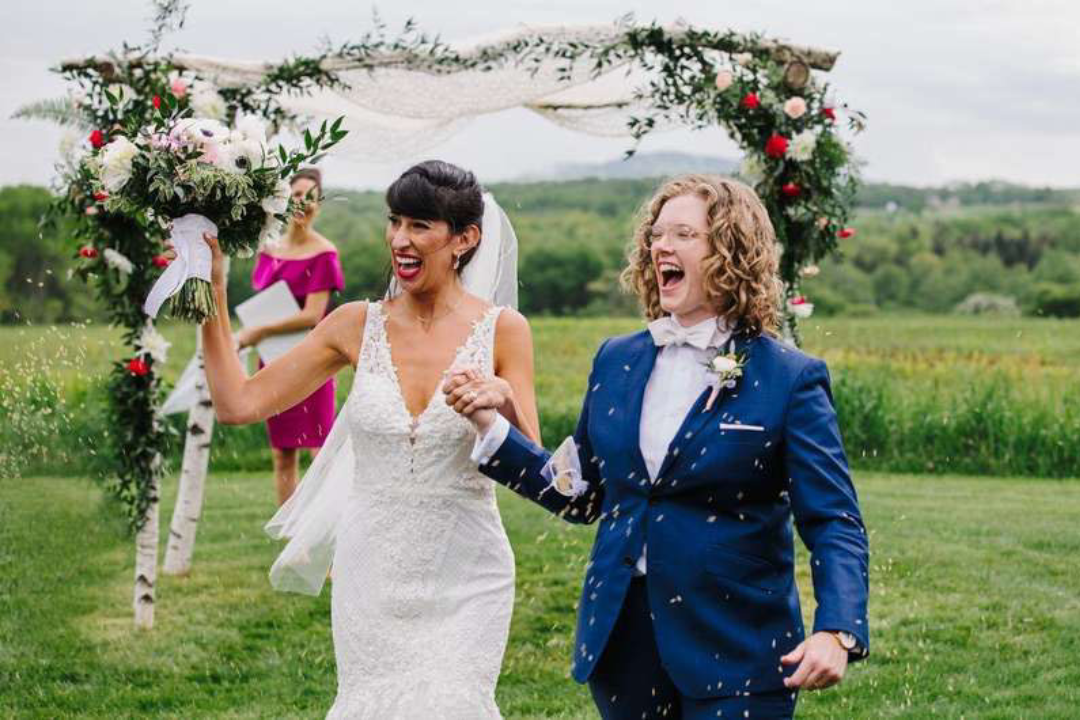
Jewish wedding ceremony script
This script has been reviewed by the ordained ministers at Universal Life Church Monastery.
A Jewish wedding also has traditional elements, many of which are centuries old. Talk to your officiant (often a rabbi) about making changes and personalizing this wedding ceremony outline to fit your needs without breaking Jewish tradition.
Signing of the Ketubah
The Ketubah is an ancient marriage contract that documents the commitment between the couple. Typically, the groom signs the contract with the rabbi and two male Jewish witnesses present, along with the bride, in private before the main ceremony begins.
Officiant: “Please gather around for this ‘ceremony before the ceremony’, the signing of the Ketubah. Bride and groom, in this quiet moment before your public wedding ceremony begins, those closest to you are here to witness the signing of the important documents that make this day a remarkable moment for you both. As you become legally husband and wife, we delight in your happiness, and we wish you only good things to come as you face life together. This beautiful Ketubah has these words for you today, and I ask the groom’s witness [NAME] to read the words.”
[Groom’s witness reads the Ketubah.]
Officiant: “I ask you both to sign the Ketubah as the first ceremonial act of your wedding day celebration.”
[Couple signs the Ketubah.]
Officiant: “Now I ask your parents to sign the Ketubah.”
[Couple’s parents sign the Ketubah.]
Officiant: “And now I sign it as well.”
[Officiant signs the Ketubah.]
Processional
The ceremony begins once guests are seated.
Opening words/welcome
Officiant to reception: “This is the day that [PARTNER A] and [PARTNER B] marry the person they love the most in the world…the one they will laugh with, live for, and love for the rest of their lives. So it is only fitting that those closest to them are here to witness this special day. Your presence at this wedding celebration is a reminder to [PARTNER A] and [PARTNER B] of how lucky they are to have you in support of their union.”
The chuppah
The chuppah is a canopy structure symbolizing the home the couple will build together following their marriage. Modern couples use the chuppah as an opportunity to customize their wedding and use it as a reflection of their unique taste and style.
Officiant: “The chuppah under which [PARTNER A] and [PARTNER B] stand is the traditional structure used in a Jewish wedding ceremony. What you see in the setting for this ceremony tells you so much about the path that brings [PARTNER A] and [PARTNER B] to be married. Today, their families are joined together, and the combined richness of their two heritages will be the foundation for their life together.
As the open sides of a chuppah symbolize hospitality, the chuppah in this ceremony invites you all to feel welcome today, for this is the day of all days that [PARTNER A] and [PARTNER B] want to share with you.”
Circling
After the couple enters the chuppah, the bride/groom circles the bride/groom seven times, symbolizing building a wall of love around the relationship. It also represents the seven days of creation.
Declaration of support
Officiant to the couple: “A marriage is a lifelong adventure. Today’s ceremony, while important, is only the beginning of that journey. Marriage is a challenge that will require [PARTNER A] and [PARTNER B] to have love and understanding. You must dedicate yourselves to each other, listen to each other, and be honest with each other. You will need laughter and forgiveness, tenderness and empathy.”
Sand ceremony
Officiant to the couple: “We will now begin the sand ceremony. Through it, [PARTNER A] and [PARTNER B] will symbolize the permanence of the commitment of their marital relationship. They will each pour separate containers of sand into one vessel.
Each of these grains represents a unique aspect of themselves. Their experiences, outlooks, feelings, and the events that shaped them into the person that stands before you. As these grains of sand intermingle in one shared vessel, they symbolize the merging of two individual lives into an inseparable pair.
[PARTNER A] and [PARTNER B], just as these grains of sand can never again be separated, so too will you be forever joined.”
Declaration of intent
Officiant to Partner A: "Do you, [PARTNER A], take this [woman, man] to be your lawfully wedded [wife, husband], to have and to hold, in sickness and in health, in good times and woe, for richer or poorer, keeping yourself unto [her, him] for as long as you both shall live? If so, answer 'I do.'"
Partner A: “I do.”
Officiant to Partner B: "Do you, [PARTNER B], take this [man, woman] to be your lawfully wedded [husband, wife], to have and to hold, in sickness and in health, in good times and woe, for richer or poorer, keeping yourself unto [him, her] for as long as you both shall live? If so, answer 'I do.'"
Partner B: “I do.”
Ring exchange
Officiant to Partner A: "[PARTNER A], as a token of your intentions, please place this ring upon [PARTNER B]’s finger and repeat after me:
‘[PARTNER B], I give you this ring as a symbol of my love and faithfulness.’"
[Partner A repeats the words while placing the ring on Partner B’s finger.]
Officiant to Partner B: "[PARTNER B], as a token of your intentions, please place this ring upon [PARTNER A]’s finger and repeat after me:
‘[PARTNER A], I give you this ring as a symbol of my love and faithfulness.’"
[Partner B repeats the words while placing the ring on Partner A’s finger.]
Blessing of the hands
Officiant to the couple: "[PARTNER A] and [PARTNER B], please join hands. Look at these hands, for they are of your closest friend. They are strong and full of love. As you join hands today, you make the promise to love each other today, tomorrow, and forever.
Your future will be built by these hands. As the years pass, these hands will love you and cherish you. The slightest touch from these hands will give you comfort. These are the hands that will hold your children. These are the hands that will keep your family as one. When you have tears of sorrow or tears of joy, they will be wiped away by these hands."
The Seven Blessings
The Seven Blessings are now recited.
- Blessing over the wine as a symbol of joy
- Blessing praising God to whom all creation proclaims praise
- Blessing praising God as creator of humanity
- Blessing praising God who created humanity in the divine image
- Prayer of hope
- Prayer for the happiness of the couple
- Prayer for the individual hope for happiness for the couple combined with prayer for joy in the messianic future
Following the Seven Blessings, the couple shares a cup of wine.
Breaking the glass
The ceremony is concluded by the tradition of the groom (or bride) stomping on glass and shattering it. This signals the audience to cheer, dance, and shout “Mazal tov!”
The Yichud
After the ceremony concludes, the final ritual takes place in the yichud or “tent of seclusion.” This is considered to be one of the most private and intimate parts of the wedding day, where the newlyweds can savor their first moments alone before the celebration continues.
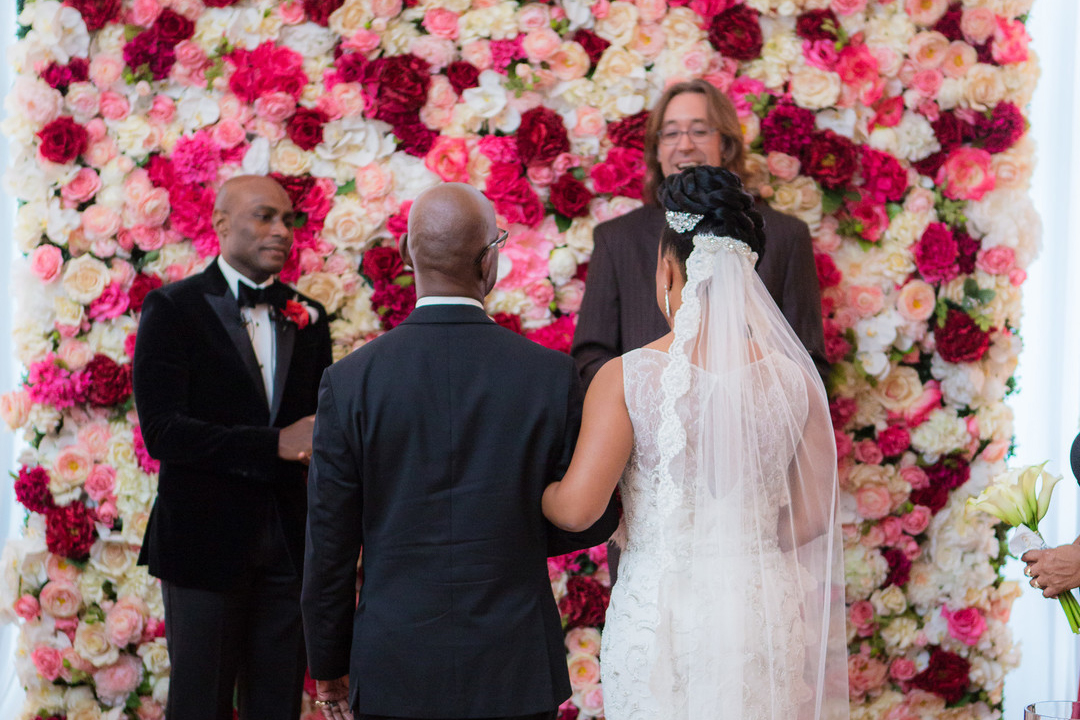
Protestant wedding ceremony script
This script has been reviewed by the ordained ministers at Universal Life Church Monastery.
There are many denominations within the Protestant faith, and the standard ceremony for each may vary. Those with a more liberal interpretation of the wedding ceremony might be open to including more nontraditional elements in the wedding script. The script below is adapted from the Book of Common Prayer, and is just one of many possible variations of a Protestant wedding ceremony.
Introductory prayer
The officiant, known as the celebrant, faces the couple and congregation and offers an introduction:
Officiant: “Dearly beloved, we have come together in the presence of God to witness and bless the joining together of this couple in holy matrimony. The bond and covenant of marriage was established by God in creation, and our Lord Jesus Christ adorned this manner of life by His presence and first miracle at the wedding at Cana in Galilee. It signifies to us the mystery of the union between Christ and His church, and holy Scripture commends it to be honored among all people.
The union of marriage is intended by God for their mutual joy, for the help and comfort given each other in prosperity and adversity, and, when it is God’s will, for the procreation of children and their nurture in the knowledge and love of the Lord. Therefore, marriage is not to be entered into unadvisedly or lightly, but reverently, deliberately, and in accordance with the purposes for which it was instituted by God.”
The interrogation
Celebrant to the congregation: “Into this union [PARTNER A] and [PARTNER B] now come to be joined. If any of you can show just cause why they may not be lawfully wed, speak now, or else forever hold your peace.”
Celebrant to the couple: “I charge you both, here in the presence of God and the witness of this company, that if either of you know any reason why you may not be married lawfully and in accordance with God's word, do now confess it.”
Celebrant to Partner A: “[PARTNER A], will you have this [woman, man] to be your [wife, husband], to live together with [her, him] in the covenant of marriage? Will you love [her, him], comfort [her, him], honor and keep [her, him], in sickness and in health, and, forsaking all others, be faithful unto [her, him] as long as you both shall live?”
Partner A: “I will.”
Celebrant to Partner B: “[PARTNER B], will you have this [man, woman] to be your [husband, wife], to live together with [him/her] in the covenant of marriage? Will you love [him/her], comfort [him/her], honor and keep [him/her], in sickness and in health, and, forsaking all others, be faithful unto [him/her] as long as you both shall live?”
Partner B: “I will.”
Celebrant to the congregation: “Will all of you witnessing these promises do all in your power to uphold these two persons in their marriage?”
Congregation responds: “We will.”
The presentation
The presentation represents the traditional “giving away” of the bride, typically followed by a hymn. Modern Protestants may opt for a poem, romantic reading, or song of their choice in place of a hymn.
Celebrant: “Who gives [PARTNER A] to be married to [PARTNER B]?”
Partner A or B’s father: “[He, she] gives [himself, herself], with the blessing of [his, her] mother and father.”
Vows exchange
Some modern Protestants might choose to write their own wedding vows, but the traditional vows most often recited are as follows:
Partner A to Partner B: “In the name of God, I, [NAME], take you, [NAME], to be my [wife, husband], to have and to hold from this day forward, for better or for worse, for richer and for poorer, in sickness and in health, to love and to cherish, until death do we part. This is my solemn vow.”
Partner B to Partner A: “In the name of God, I, [NAME], take you, [NAME], to be my [husband, wife], to have and to hold from this day forward, for better or for worse, for richer and for poorer, in sickness and in health, to love and to cherish, until death do we part. This is my solemn vow.”
The blessing and exchange of rings
The celebrant offers a blessing on the rings: “Bless, O Lord, these rings as a symbol of the vows by which this couple have bound themselves to each other, through Jesus Christ our Lord.”
Congregation responds: “Amen.”
Partner A and Partner B place the rings on each other’s fingers and say: “I give you this ring as a symbol of my love, and with all that I am, and all that I have, I honor you, in the name of the Father, and of the Son, and of the Holy Spirit.”
The celebrant joins the right hands of both partners and says: “Now that [NAME] and [NAME] have given themselves to each other by solemn vows, with the joining of hands and the giving and receiving of rings, I pronounce them [husband and wife, husband and husband, wife and wife] in the name of the Father, and the Son, and the Holy Spirit. Those who God has joined together, let no man put asunder.”
Congregation responds: “Amen.”
Concluding prayers
The celebrant asks the congregation to stand and repeat the Lord’s Prayer:
All: “Our Father, who art in heaven, hallowed be thy name. Thy kingdom come, thy will be done, on earth as it is in heaven. Give us this day our daily bread, and forgive us our trespasses, as we forgive those who trespass against us. And lead us not into temptation, but deliver us from evil, for thine is the kingdom and the power, and the glory, forever. Amen.”
In traditional Protestant weddings, the celebrant will direct the couple to kneel while further blessings and songs are offered. The celebrant then addresses the kneeling couple and recites another blessing:
Celebrant: “May God bless you and keep you; may the Lord mercifully with his favor look upon you, filling you with all spiritual benediction and grace; that you may faithfully live together in this life, and in the age to come have life everlasting. Amen.”
Celebrant to the congregation: “The peace of the Lord be with you always.”
All respond: “And also with you.”
Finally, the couple stands to face each other while the celebrant offers a final line to end the ceremony:
Celebrant: “[NAME] and [NAME], having witnessed your vows of love to one another, it is my joy to present you to all gathered here as [husband and wife, husband and husband, wife and wife]. You may now kiss!”
Closing/invitation to reception
Officiant to all: “Thank you all for joining in this joyous occasion for [PARTNER A] and [PARTNER B]! They now invite you to join them for a reception at [LOCATION]. Thank you all!”
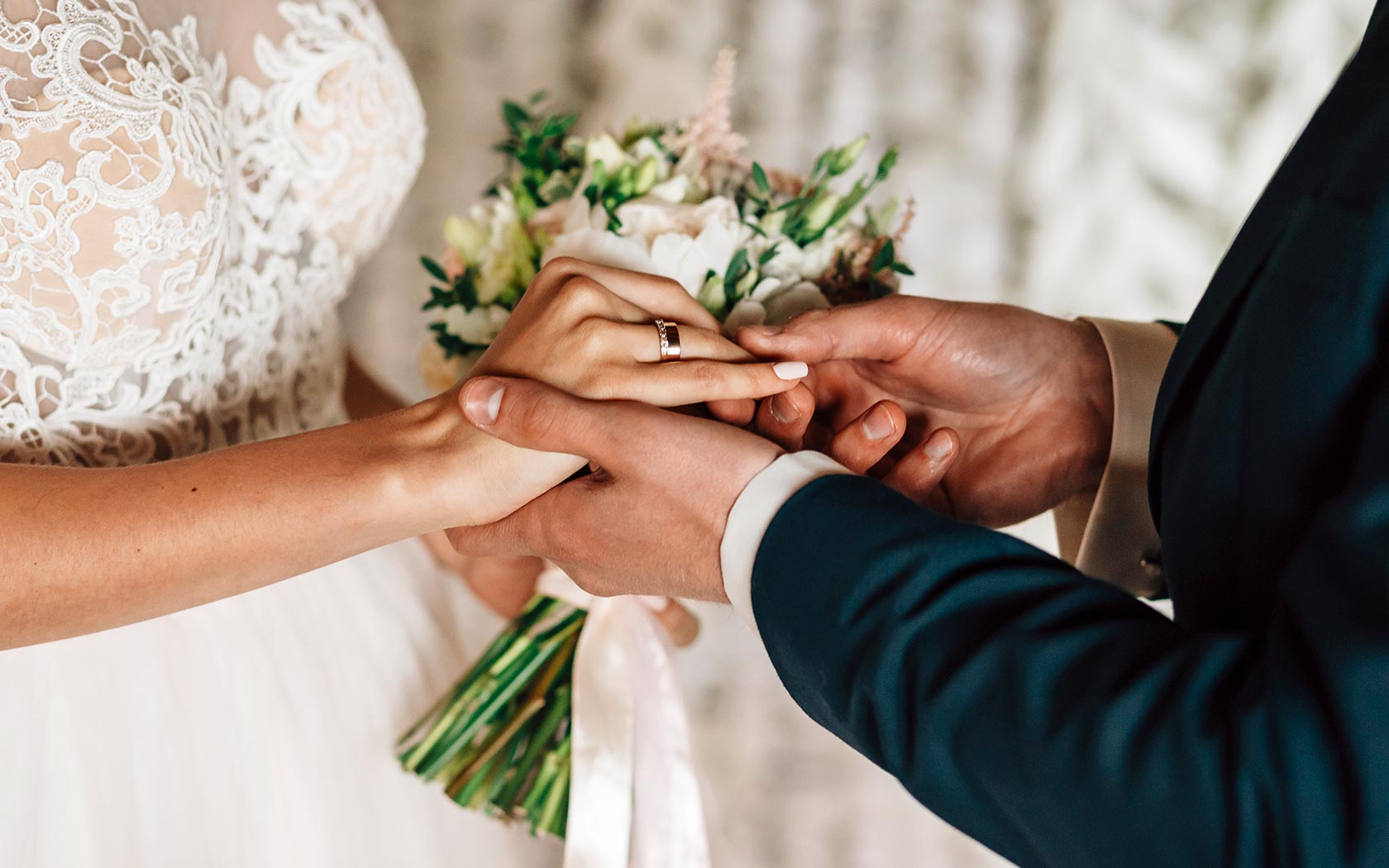
4 Tips for writing your own ceremony script
While writing your wedding ceremony script might feel daunting, these tips can help take the pressure off and provide some much-needed guidance on how to bring your ceremony vision to life—whatever that means to you.
1. Talk with your partner
Writing your script is an opportunity to reflect on the significance of your relationship before you enter into marriage. Talking with your partner about your ideas and desires for your wedding ceremony is an important first step—it helps you get aligned on a mutual vision and ensures the ceremony is a reflection of what matters most to you as a couple.
2. Work with your officiant
Your officiant can provide practical advice on how to get started crafting your ceremony script, and some might even have an outline for you to work from. Since your officiant has most likely conducted their fair share of wedding ceremonies, they’re an excellent resource for any questions you might have.
3. Don’t procrastinate
While you certainly don’t need to memorize your wedding ceremony script, don't put it off until the last minute—especially if you plan on writing your own vows. Procrastinating until the week of your wedding can add a ton of pressure to an already hectic time, so do yourself a favor and get started early!
4. Consider the length of your script
While your wedding ceremony script should be whatever you want it to be, being mindful of time and length is something your guests will appreciate. Anything longer than 30 minutes might leave guests checking their watches! Once you’ve written a draft and have the chance to rehearse it, you’ll find that you can pack plenty of meaning and resonance in less than 15 minutes.

Simple wedding ceremony script starter outline
Now that you’ve read some ceremony script examples, you can confidently start writing your own! No matter what you decide to include, what matters most is that the words shared are from the heart and represent what your marriage means to you. Here’s an ultra-simple outline to help you start formulating your own wedding script for officiants to use.
- Officiant’s welcome
- Short sermon to the congregation
- Charge to the couple
- Declaration of the intent to marry
- Vows
- Ring exchange
- Pronouncement of marriage
- Conclusion and invitation to reception
FAQs about wedding ceremony scripts
Find answers to any lingering wedding ceremony script questions below.
How do I personalize my wedding ceremony script?
Start by nailing down the overall format of your script, including the order of the ceremony and the role of the officiant. Then weave in personal elements significant to you and your partner, such as customizing your vows, a special unity ceremony, or a reading that holds meaning. Remember, there’s no rule that says you have to follow a traditional wedding ceremony script.
How do I start a wedding ceremony script?
Most wedding ceremony outlines start with the wedding officiant welcoming guests and thanking them for joining in the wedding day. Religious ceremonies may start with a reading from the Bible or whatever is customary for different faiths. That said, your ceremony script can begin however you like, whether that’s opening with a meaningful quote, poem, or endearing story about you and your partner.
Where can I find wedding ceremony scripts?
The best place to find both religious and non religious wedding ceremony scripts is online. You can find downloadable pre-written scripts by searching for a specific religious denomination or the mood you want your ceremony to take. For extra inspiration, search for wedding ceremony videos on YouTube to get a feel for what different scripts sound like during a real ceremony.
How long should the officiant speak at the wedding?
Your officiant wedding script should get straight to the point while adding personality. Talk to your celebrant about the parts that are most important to you, such as giving a blessing to the couple. However, if the sermon isn’t essential to you, feel free to shorten it. The last thing you want to do is bore your guests, so concise yet interesting is best.
Summarizing ceremony and officiant wedding scripts
Although there is a bit of protocol surrounding the order of service, there is a lot of freedom within with most scripts. If you’re particularly religious, you may want to chat with your priest, rabbi, or pastor about how to best adapt your ceremony. However, if you’re not planning on a religious ceremony, chat with your partner about expectations and how to go from expected to highly personal.
As you finish off your wedding planning, Zola is here to help every step of the way. Whether designing custom wedding invitations or putting the final touches on your wedding registry, Zola has all the expert advice you’ll need to make your wedding vision come to life.
- Expert advice/
- Wedding planning 101/
- Wedding day/
- 8 Wedding Ceremony Scripts to Borrow & Printables
Find even more wedding ideas, inspo, tips, and tricks
We’ve got wedding planning advice on everything from save the dates to wedding cakes.







